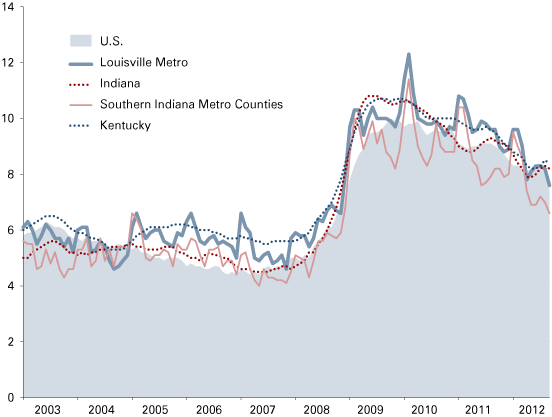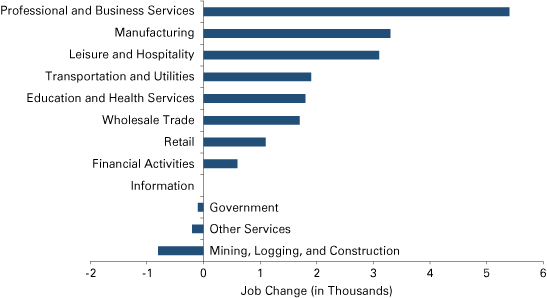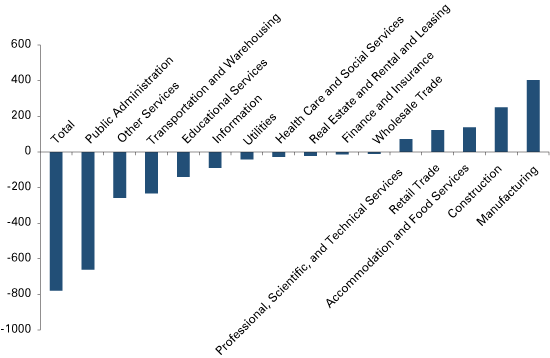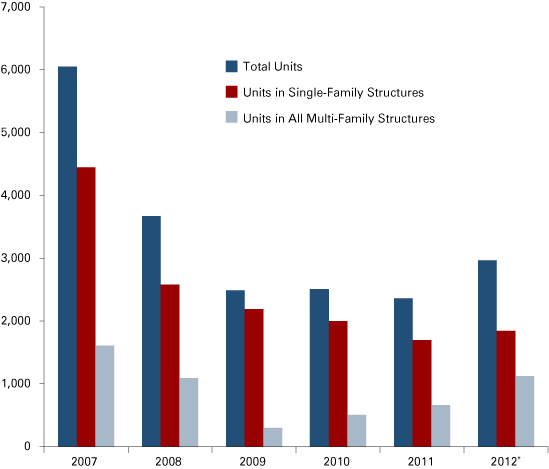Louisville Forecast 2013
Sanders Chair in Business, Indiana University Southeast, New Albany
As 2012 came to an end, the Louisville metro1 was just shy of hitting a pre-recession peak in nonfarm payrolls. As of September 2012, payrolls were just 7,000 short of the 627,000 nonfarm payrolls that the Louisville metro observed in January of 2008. This progress comes with very strong year-over-year growth in nonfarm payrolls, well exceeding the U.S., Indiana and Kentucky. As we move into 2013, will this high growth be sustained, or can we expect growth to level off to levels consistent with the national, Indiana and Kentucky economies?
The 2013 outlook for the Louisville metro is for growth to continue, but likely decelerate compared to 2012. The national economy in 2013 will be affected by uncertainty surrounding the fiscal cliff. Slower nationwide growth will have an impact locally. Consequently, slower payroll growth for the Louisville metro is expected in 2013.
Labor Markets
The unemployment rate for the Louisville metro has trended down since 2011 and just moved under the national rate as of September 2012. The Southern Indiana area of the metro region fared better, with rates hovering around 7 percent and the lowest among the region and both states (see Figure 1). Despite a lower unemployment rate, the number of unemployed remains stubbornly high—nearly double than prior to the recession.
Figure 1: Louisville Unemployment Rates, March 2003 to September 2012

Source: Bureau of Labor Statistics
Sector Growth
The professional and business services sector was a key sector in overall job growth for the Louisville metro last year. Professional and business services added 5,400 jobs out of 19,300 added for the entire region, as of September 2012 (see Figure 2). However, the professional and business services sector appears to be decelerating compared to early gains. Year-over-year gains had reached 11.3 percent earlier in the year, but have declined to 7.0 percent in September. This is likely reflective of an overall soft economy, but could also be indicative of subsequent slowing of total payrolls in the metro region.
Figure 2: Louisville Metro Year-over-Year Job Change by Sector, 2011 to 2012

Note: Data are for September of each year.
Source: FactSet
Leisure and hospitality also showed solid gains, reflective of improving sentiment among consumers. Education and health services continued to show gains, but at a slower pace compared to recessionary and post-recession years. While housing continues to recover, construction continues to face challenges in overall employment. Despite the increase in building permits, construction employment remains flat compared to last year. Transportation and utilities, as well as retail and wholesale trade, showed moderate gains over 2012.
Manufacturing
Even though total manufacturing payrolls are lower today than 10 years ago, it continues to be an important payroll sector for the Louisville metro and Southern Indiana. While not the leading sector in job growth this past year, manufacturing did see another year of gains and contributed to overall job growth, adding 3,300 jobs. Much of this growth came in the durable goods sector, with local manufacturers in automotive and related automotive parts being responsible for a good portion of this growth. Automotive production, perhaps driven by pent-up demand, has been a major driver of gains in manufacturing. A key issue is whether gains can be sustained once auto sales move past the pent-up demand phase. Recent indicators suggest that a bottoming in manufacturing has occurred, but considerable uncertainty remains, largely due to weak domestic and global demand. Weak demand is the biggest challenge facing manufacturing. The sector may get an offsetting boost from encouraging signs in housing.
Southern Indiana
Payroll gains in Southern Indiana were lower due to declines in public administration, likely the result of reductions in payrolls at Clark County’s Census operations (see Figure 3). Removing the impact of public administration declines, payroll growth in Southern Indiana was at a subdued pace. Manufacturing was quite strong and contributed to overall payroll growth. However, slowdowns in manufacturing, prompted by continued weak national demand, will take away from overall payroll growth in 2012 and 2013.
Figure 3: Year-over-Year Job Change by Sector for Southern Indiana’s Louisville Metro Counties, 2011 Q1 to 2012 Q1

Note: Some industries are unavailable due to disclosure issues.
Source: STATS Indiana, using Quarterly Census of Employment and Wages data
Housing
Housing continues to see improvement. Overall permits are up, and housing values continue to rebound. As of September, building permits in the region continue to be down 42 percent from 2007. However, September 2012 year-to-date permits have already exceeded total permits for 2011 (see Figure 4). Gains to housing will continue but at a moderate pace.
Figure 4: Louisville Metro Building Permits, 2007 to 2012

*2012 data are year-to-date through September.
Source: State of the Cities Data Systems
Outlook
Last year’s outlook, as presented at the annual Economic Outlook program, was that payrolls would surprise to the upside and exceed expectations. Indeed, year-over-year payroll gains for the Louisville metro have been the highest since the 1990s. Contributing to these gains were professional and business services, manufacturing, and leisure and hospitality. For 2013, growth will begin to decelerate due to continued weak domestic and global demand. The region’s unemployment rate will see gradual declines, but the number of unemployed will continue to remain higher than pre-recession levels. This past year’s record of year-over-year job gains will be tough to match. For that reason, expect slower payroll gains for 2013.
Note
Also in this Issue…
- International Outlook for 2013
- U.S. Outlook for 2013
- Financial Outlook for 2013
- Indiana's Outlook for 2012
- Indiana's Agricultural Outlook for 2013
- Three Key Indicators—Forecasts for Jobs, Income and Productivity
- Anderson Forecast 2013
- Bloomington Forecast 2013
- Columbus Forecast 2013
- Evansville Forecast 2013
- Fort Wayne Forecast 2013
- Gary Forecast 2013
- Indianapolis-Carmel Forecast 2013
- Lafayette Forecast 2013
- Louisville Forecast 2013
- Muncie Forecast 2013
- Richmond Forecast 2013
- South Bend and Elkhart Area Forecast 2013
- Terre Haute Forecast 2013




